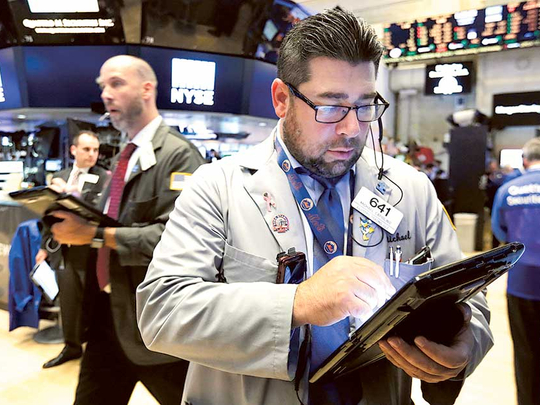
LONDON: A sterling plunge and underwhelming US jobs data on Friday muddied the outlook for world financial markets, with investors left questioning central bank policy as a messier-than-expected Brexit fallout and US presidential election loom.
Sterling recouped some losses after plunging almost 10 per cent as growing fears of a “hard” exit by Britain from the European Union sent a shiver through world markets.
S&P 500 futures pointed to a flat open on Wall Street, with its advance from recent lows having stalled this week.
US employment growth unexpectedly slowed for the third straight month in September, which could make the Federal Reserve more cautious about raising interest rates.
Markets have been dominated by a policy shift from the Bank of Japan last month, the resurgence in talk of the European Central Bank possibly tapering its bond buying programme, and the cloudy outlook for a Fed rate hike.
The sustainability of unconventional easing programmes conducted by the world’s major central banks, and whether they may be counterproductive, are at the front of investors’ minds, Goldman Sachs analysts said in a note.
British Prime Minister Theresa May has this week set a March deadline for beginning the formal departure process from the EU, and stressed the bad side-effects of low rates and quantitative easing (QE).
A growing market belief that Britain is heading for a ‘hard Brexit’ outside the European Union’s single market, which could hurt manufacturers and the vital financial services industry, has pummelled the pound this week.
Sterling slumped as much as 10 per cent in Asia as it crashed through key support levels, triggering a wave of selling. It recovered in European trading but was still down 2.7 per cent at $1.2271.
“This move has shaken things in sterling and a huge amount of any outstanding positioning will have been washed out, and we may be starting from a new, even more nervous footing,” said Citi FX trader Sam Underwood.
While the FTSE 100, dominated by global, dividend-paying bluechips rose, the more domestically focused UK madcaps index erased earlier gains and fell 0.5 per cent in a sign of risk aversion among investors towards UK assets.
The STOXX 600 has fallen by around 7 per cent since the start of 2016, with investors pulling funds from European equities for 35 straight weeks, the longest streak on record, according to Bank of America Merrill Lynch.
British gilt yields also rose sharply.
The 10-year gilt yield was up 21 basis points this week at 0.96 per cent and on track for the biggest one-week rise since August 2015.
“The pound used to be a relatively simple currency that used to trade on cyclical events and data, but now it has become a political and structural currency. This is a recipe for weakness given its twin (budget and current account) deficits,” said David Bloom, global head of FX research at HSBC.
US ELECTION NEARS Friday’s US employment report was the last before the Fed’s Nov. 1-2 policy meeting. Investors see almost no chance of a rate increase at that meeting given how close it is to the Nov. 8 presidential election.
Non-farm payrolls rose 156,000, down from a revised gain of 167,000 jobs in August, the Labor Department said. Economists polled by Reuters had expected employers to add 175,000 jobs last month.
A disorderly reaction to possible US interest rate hikes could disrupt capital flows and heighten asset price volatility in Asia, the International Monetary Fund said on Thursday.
Elsewhere in currency markets, the dollar edged down 0.8 per cent against the yen to 103.1 after hitting its highest level in a month on Thursday.
The euro rose 0.2 per cent to $1.1177, but was still poised to shed about 1 per cent for the week.
Gold recovered from earlier losses and was up 0.63 per cent. It last stood at $1,262.76.
Silver rose 1.6 per cent, bouncing from a four-month low of $17.1525 per ounce.
Oil prices steadied after US crude broke through $50 a barrel overnight, spurred by an informal meeting among the world’s biggest producers on output cuts and falling US crude inventories.
US crude futures gave up earlier gains and were down 0.4 per cent at $50.47, just below Thursday’s four-month high of $50.63. Brent fell 0.6 per cent but is close to its highest levels this year.












